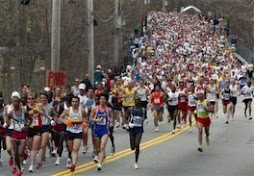Recently, I had someone ask me about my training philosophy (How do I go about training for distance racing?). Well, I have always had a fairly simple training approach, but I've never really had to explain it in simple terms to a non-runner. My philosophy follows very closely the training methods of legendary distance coach Arthur Lydiard. Lydiard believed the most "trainable" system was the aerobic system. He said you should spend most of your time just running miles and building endurance. You follow that up with training on hills to build power and strength in the legs, then you spend 4 weeks or so training your anaerobic system. Finally, you work on speed and rest for the big race.
Well, Lydiard was really good at explaining the science behind his training method, but I like to sum it all up with this phrase "Lungs, legs, wheels, and thrills"! I believe that simple phrase (in that order) correctly summarizes the proper phases of training.
LUNGS--The first thing you do in distance training is build up your lungs. Distance running is a very aerobic activity, so you have to run lots of miles with the purpose of expanding your aerobic capacity. For 10-12 weeks, you should just run mileage at a comfortable pace, increasing your mileage each week. This phase of training is the foundation for everything you will do for the rest of the season.
LEGS--With the proper foundation, you can begin to tackle the next challenge of distance running, anaerobic capacity. Everyone that has ever run hard for an extended period knows that eventually your legs begin to feel heavy, like lead. Well, in order to train your legs for this part of the race, you have to train at your lactate threshold (this is the point where lactic acid begins to accumulate in your blood stream AND it is why your legs begin to feel heavy). So, what does that mean in terms of training? Intervals and Fartlek training.
WHEELS--When I was a kid, we would say that someone who was really fast, "had wheels". They were so fast, it was as if they had wheels for feet. The next phase in training is developing the wheels, the speed. You should always work on speed to some degree, but the last few weeks of training should be largely devoted to fine tuning your turnover. Speedwork is short bouts of fast running with lots of rest. Volume of running should be kept low.
THRILLS--This is the easy part of the training. The last week (or more for longer races) should mostly be active recovery. If your legs ever feel tired during any of these workouts, you probably take the day off. Intensity should be very low, as should volume. There is a scene from the running movie Without Limits where Coach Bill Bowerman gave his star, Steve Prefontaine, a very short workout the day before the NCAA Championships. Prefontaine complained about the workout's lack of intensity, and the old coach replied, "The hay is in the barn." At this point in your training, you are ready. Nothing you do in this week will help you on race day (but you could certainly do damage to your legs by running too hard). So, you just need to rest, wait for the race, and dream about the thrill of victory.
Subscribe to:
Post Comments (Atom)


2 comments:
thats a great slogan!!
Hey, great post and i plan on stopping buy from time to time. i'll be runnning my fourth marathon at cowtown (did white rock 3 other times) and am wishing you good luck as you try to win three in a row. love the slogan. im now in the thrills part of training.
Post a Comment